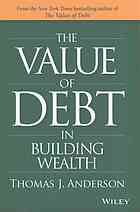

Most ebook files are in PDF format, so you can easily read them using various software such as Foxit Reader or directly on the Google Chrome browser.
Some ebook files are released by publishers in other formats such as .awz, .mobi, .epub, .fb2, etc. You may need to install specific software to read these formats on mobile/PC, such as Calibre.
Please read the tutorial at this link: https://ebookbell.com/faq
We offer FREE conversion to the popular formats you request; however, this may take some time. Therefore, right after payment, please email us, and we will try to provide the service as quickly as possible.
For some exceptional file formats or broken links (if any), please refrain from opening any disputes. Instead, email us first, and we will try to assist within a maximum of 6 hours.
EbookBell Team

4.1
50 reviews"The Value of Debt in Building Wealth will greatly expand upon and go beyond the ideas presented in The Value of Debt by framing out debt strategies for individuals who are generally between 25 and 40 years old and in the first stages of accumulating debt. Topics discussed in the book include: - Debt-to-Asset versus Debt-to-Income ratios: where they intersect, how they tend to move over time, and how these ratios can help guide individuals and families - Rent versus buy; a detailed discussion and analysis - A discussion of student debt and what to do with it - Debt overlay vis-. is one's investment portfolio: where should you direct your cash flow funds? A debate, discussion, and flow chart - Maximizing retirement-related investment opportunities--starting early matters - Saving for children's college and graduate education - The importance of liquidity, and why individuals should be willing to pay for it - The importance of lines of credit including asset based portfolio loans - Fixed vs. floating debt; what you are really paying for, and whether it is worth it - Investment basics and important simple concepts to understand as you move forward"--
"The Value of Debt in Building Wealth will greatly expand upon and go beyond the ideas presented in The Value of Debt by framing out debt strategies for individuals who are generally between 25 and 40 years old and in the first stages of accumulating debt. Topics discussed in the book include: - Debt-to-Asset versus Debt-to-Income ratios: where they intersect, how they tend to move over time, and how these ratios can help guide individuals and families - Rent versus buy; a detailed discussion and analysis - A discussion of student debt and what to do with it - Debt overlay vis-. is one's investment portfolio: where should you direct your cash flow funds? A debate, discussion, and flow chart - Maximizing retirement-related investment opportunities--starting early matters - Saving for children's college and graduate education - The importance of liquidity, and why individuals should be willing to pay for it - The importance of lines of credit including asset based portfolio loans - Fixed vs. floating debt; what you are really paying for, and whether it is worth it - Investment basics and important simple concepts to understand as you move forward"